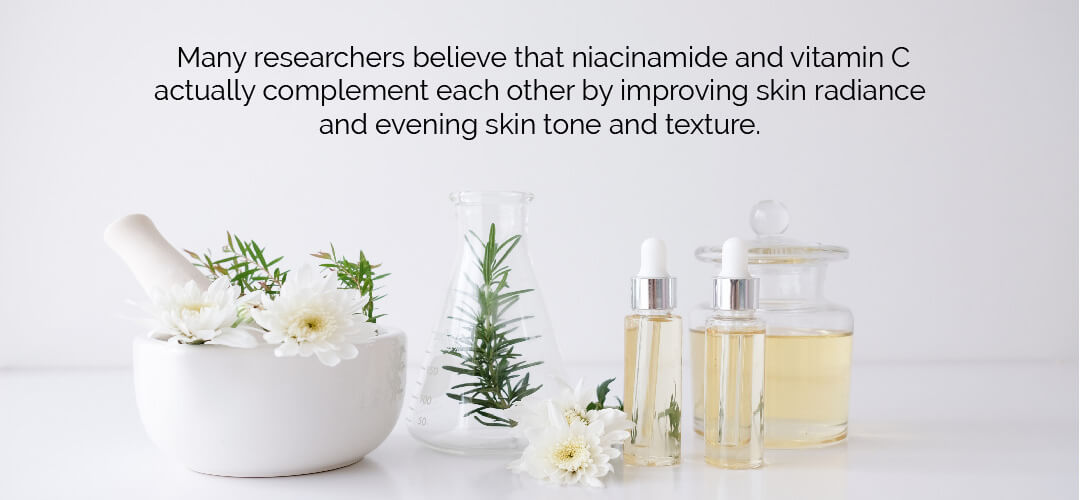Putting together your skincare routine is a lot more than just knowing the proper order to use your products, which is confusing in and of itself so I wrote about it, but it is also knowing what ingredients work together and how they interact with each other. For the longest time, it was believed that niacinamide and vitamin C shouldn’t be used together. I even wrote a couple of blog posts discouraging readers from using them at the same time. However, there may be a reason to believe that this pairing isn’t so terrible after all!
The Argument Against Niacinamide and Vitamin C
There is a fear of using vitamin C and niacinamide together because it’s believed that they’ll cancel each other out, rendering both formulas ineffective. This fear is only increased by the fact that vitamin C is an extremely finicky ingredient to work with, making it super important that it’s formulated correctly. While L-ascorbic acid is a naturally-occurring form of vitamin C, niacinamide is a form of niacin or vitamin B3. When mixed together in water, they form a 1:1 complex that turns the solution yellow, rendering both compounds useless. This may be the result of a donor-acceptor interaction between L-ascorbic acid (donor) and niacinamide (acceptor). And in the presence of UV light and oxygen, the two compounds may even generate the very reactive hydrogen peroxide compound through a 4-step chain reaction.
The other issue is that when vitamin C and niacinamide are combined they turn into a yellow liquid. This leads most people to believe that it causes a negative reaction which makes both products ineffective. I’ve even seen some claims saying that the vitamin C instantaneously oxidizes and you cannot use it anymore. But these fears are unjustified because the yellow combination is actually a result of a charge-transfer interaction that converts the niacinamide and ascorbic acid into niacinamide ascorbate.
The Argument For Niacinamide and Vitamin C

There are many in the skincare world who believe that using these two together is actually perfectly safe and even beneficial to the skin. This is due in part to the fact that most research that claims niacinamide and vitamin C can’t be used together are from over 40 years ago. A lot of research has been done since then! Many in this camp believe that these ingredients actually complement each other by improving skin radiance and evening skin tone and texture.
Cosmetic chemist Stephen Ko explained to The Klog recently that, “while the combination of niacinamide and ascorbic acid in certain conditions can form niacin, it takes a lot of time or heat. When you’re just layering products the amount formed is likely minimal. Niacin is undesirable because it can cause really bad flushing, which you shouldn’t confuse with simple irritation. Flushing is quite persistent and rash-like, though temporary. So unless you’re seeing flushing, you’re likely fine with the combination.”
Unlike unstable and finicky L-ascorbic acid, niacinamide is tough and factors like increased temperature will not have an impact on its effectiveness. Because of this (and what Ko mentioned earlier), it takes a very high amount of heat over an extended period of time to cause this reaction. And even then, only a small amount of product will actually change. If this is still something that you are concerned about, be sure to store your products in a cool, dark area. Or you can even invest in a micro-fridge specifically for your products.
Niacinamide Friendly Vitamin C Derivatives
If you’re still unsure about using niacinamide and vitamin C together, there is also the option of using the niacinamide-friendly vitamin C derivative tetrahexyldecyl ascorbate. The studies conducted about the interaction between niacinamide and vitamin C have only been done on pure vitamin C, not it’s derivatives.
Tetrahexyldecyl ascorbate is a form of vitamin C that is oil-soluble. What makes THD ascorbate special is that it has been shown in peer-reviewed studies to penetrate both the epidermis and dermis (Clinics in Dermatology). I cannot find any studies that demonstrate other forms of vitamin C to penetrate the skin this far. Like all of the other vitamin C derivatives on the skin, THD ascorbate has to be converted to L-ascorbic acid within the skin to be active. Which means that 20% THD ascorbate is more likely to effectively be (I’m guessing) 10-15% L-ascorbic acid. That said, it’s also more stable than L-ascorbic acid!
Early studies show that the combination of THD ascorbate and niacinamide can help with the reduction of UV-induced hyperpigmentation!
Bottom Line
While early studies show that using L-ascorbic acid and niacinamide together can render them (at best) ineffective and (at worst) toxic, there is an argument to be made that these studies are outdated or inaccurate and that it’s perfectly safe to use these together. Still, if you are concerned about this combination you can always use a derivative like THD ascorbate, which there is a reason to believe will help reduce UV-Induced hyperpigmentation.

